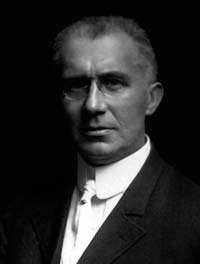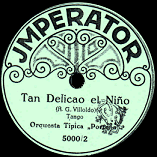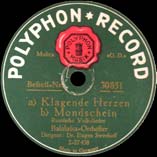By
Germany, war, record... Tango

leven years after the American Thomas Alva Edison in 1877 introduced his invention, the phonograph, to the world, the German Emile Berliner also put forward his invention: the gramophone, in 1888.
 Both mechanical instruments fulfilled the same task, to record sound on a solid body for a later audible playback. But, what was the difference between Edison´s phonograph and Berliner´s gramophone? Basically on three items. Two of them of technical character and the third, maybe the most important, of industrial and commercial character.
Both mechanical instruments fulfilled the same task, to record sound on a solid body for a later audible playback. But, what was the difference between Edison´s phonograph and Berliner´s gramophone? Basically on three items. Two of them of technical character and the third, maybe the most important, of industrial and commercial character.
While the phonograph recorded sound in helicoidal manner on a cylinder with vertical cut recording (cylinder phonograph), the gramophone, instead, did it on a disc face in spiral manner (disc gramophone) and by lateral cut recording. From 1890 until 1901 these two sound recording and playback methods, put forth betweeen both inventors and the persons who had already entered the business of this extraordinary invention of the century, a great number of problems resulted in arguments, claims and lawsuits. If we think that to know the positions at issue in this vast tangle, it would be necessary to write various volumes and in small fonts. It is not necessary to say that up to this point of the circumstances, the only winners were the lawyers. The critical restraint at issue besides less important others, was the possibility of using bee wax or any other type as support in sound recording, a registered patent by Alexander Graham Bell (inventor of the telephone) and Charles Summer Tainter, both founders of the Volta Laboratory.
 In the very beginning of 1902, at last the parties agreed to trade and make joint use of their patents: the Victor Company founded in 1901 (which owned Berliner´s rights), the Columbia Graphophone Company, founded in 1889 as (Columbia Phonograph Company) by E. D. Easton and Roland Cronlin, both stenographers in the Supreme Court and with acquired rights for the exploitation of Edison phonograph, and lastly the American Graphophone Company, originated in the Volta Geraphophone. From this very important event gramophone and disc quickly took notable advantage over phonograph and its cylinder, due to its lower production cost and to the simplicity of its mechanism in comparison with the more complicated, applied to the phonograph machinery.
In the very beginning of 1902, at last the parties agreed to trade and make joint use of their patents: the Victor Company founded in 1901 (which owned Berliner´s rights), the Columbia Graphophone Company, founded in 1889 as (Columbia Phonograph Company) by E. D. Easton and Roland Cronlin, both stenographers in the Supreme Court and with acquired rights for the exploitation of Edison phonograph, and lastly the American Graphophone Company, originated in the Volta Geraphophone. From this very important event gramophone and disc quickly took notable advantage over phonograph and its cylinder, due to its lower production cost and to the simplicity of its mechanism in comparison with the more complicated, applied to the phonograph machinery.
I would say that here is where chilhood ended and the adult age of record started. Since then, 1903, hundred of manufacturers of talking machines and their components as well as many small record producers started to appear in Germany. This event so challenging produced during the following five years a commercial crisis which made Carl Linstrom think of organizing the Union of manufacturers of talking instruments, on one side, and the Polyphon, which grouped the record small manufacturers. Carl Lindström was the founder of Parlophon in 1896. It can be said that from 1908 to 1914, the phonograph and record empire devised and made real by Lindström was so impressive that there was no city or town in any country of the world where machines or German discs could not be found, with so many models and different trade marks which were and will be the disconcert of collectors.
 The declared and violent challenge by Lindström to the companies firmly established in the United States and Great Britain, favored the German economy which received contributions similar to those of other industrial exportations like those of sewing machines, tools, electrical devices, etc., which because of their low cost, were bought by people with less money. But Lindström soon realized that this XX century was beginning with the growing industry playback music and, as quickly as he could, organized the shipping of portable recording machines to every important city in the world with the express objective of making takes in wax to every singer, musician or group who had not signed an exclusive contract with the known companies. Then a new style of disc recording and commercialization started.
The declared and violent challenge by Lindström to the companies firmly established in the United States and Great Britain, favored the German economy which received contributions similar to those of other industrial exportations like those of sewing machines, tools, electrical devices, etc., which because of their low cost, were bought by people with less money. But Lindström soon realized that this XX century was beginning with the growing industry playback music and, as quickly as he could, organized the shipping of portable recording machines to every important city in the world with the express objective of making takes in wax to every singer, musician or group who had not signed an exclusive contract with the known companies. Then a new style of disc recording and commercialization started.
Buenos Aires, that in 1910 already had 1.300.000 inhabitants, was one of the world cities preferred by Polyphon which set up a very original way of producing and commercializing the sale of a greater quantity of records. The question was to arrange with the interested dealer, the sale with payment in advance of a certain amount of records in exchange for the choice of the interpreter and if he also liked the label would bear his name or exclusive trademark printed. Many were the interested dealers and also were many the tango musicians and composers who dreamed of committing to that magical disc groove, their modest or great knowledge, learnt at the conservatory or with the music teacher in the neighborhood, or with their ears helping in this effort. So in this simple manner each of them had their opportunity and so we had the chance of knowing authors, compositions and tango titles written on those records, but in many cases there were neither commentaries written, nor sheet music published, nor even manuscripts kept, but anyhow they are there. Those discs were, are, and will go on being the permanent agent of the invisible interpreter, that today either for those who study or those, such as we, who investigate the mysteries still hidden in tango serve us as an element of ideal comparison.
 When World War I began, the two big and main phonographic companies Victor and Columbia took as immediate measure, the protection of all the matrixes in their storehouses at the European countries, carrying them to safer places and at the same time notably decreasing the activities with recordings. The two mentioned enterprises and other European companies ceased to manufacture those machines which produced musical sound to nourish the life of human spirit and started during war time, in a direct or indirect way, with the manufacturing of elements which would serve for other devices, but this time, they would only make the sound previous to human misery. The record shops in Buenos Aires soon felt the cold from war. Europa did not send goods due to the risk of the voyage and the United States sent very few wares. But Lindström´s Polyphon kept on sending discs at the cost of risk and losses until near the end of l915. Some of the trademarks produced by him for record labels were: PARLOPHON, POLYPHON, ANKA, KRONOPHON, HOMOPHON, HOMOKORD, BEKA, FAVORITE, OROPHON, EXPOSICIÓN, SCALA, ERA, DACAPO, JUMBO, LYROPHON, etc.
When World War I began, the two big and main phonographic companies Victor and Columbia took as immediate measure, the protection of all the matrixes in their storehouses at the European countries, carrying them to safer places and at the same time notably decreasing the activities with recordings. The two mentioned enterprises and other European companies ceased to manufacture those machines which produced musical sound to nourish the life of human spirit and started during war time, in a direct or indirect way, with the manufacturing of elements which would serve for other devices, but this time, they would only make the sound previous to human misery. The record shops in Buenos Aires soon felt the cold from war. Europa did not send goods due to the risk of the voyage and the United States sent very few wares. But Lindström´s Polyphon kept on sending discs at the cost of risk and losses until near the end of l915. Some of the trademarks produced by him for record labels were: PARLOPHON, POLYPHON, ANKA, KRONOPHON, HOMOPHON, HOMOKORD, BEKA, FAVORITE, OROPHON, EXPOSICIÓN, SCALA, ERA, DACAPO, JUMBO, LYROPHON, etc.
Also until that year he controlled the production and commercialization of Fonotipia and Odeon in Germany. In almost all these trademarks mentioned, there are many names of an important career in folk and tango music who recorded on these records. Between 1910 and 1915, are added other interpreters who recorded a lot of tangos, also on labels registered in Argentina and who were associated with the same producer such as: ARENAS, FERRARIS, CHANTECLER, AVELINO CABEZAS, VICTORIA RUBIN, TOCASOLO, ARTIGAS, PHONO D'ART, AMÉRICA, URUGUAYO, SONORA, ATLANTA, etc. Of all these mentioned the most popular was ATLANTA, which by Lindström's authorization used the same logo as DACAPO RECORD, replacing only the name.
A lot of faces of these discs still keep unpublished versions such as tango titles, groups or soloists as interpreters and author names who surely got their inspiration from that Buenos Aires loaded with aesthetic feeling and fertile originality. Many pages like this would be needed to tell and comment facts in connection with the present work, but I had intended to portray in a simple way that "being" who worked indefatigably for the sake of phonography and the other, who unconditionally bequeathed us his works recorded on a waxed face. Some musicians who recorded for those German discs were: Segundo Pomar, Manuel Campoamor, Arturo Sianco, the maestros Reynoso and Heyberger, Alberto Poggi, Carlos Mauricio Pacheco, Arturo Calderilla, Blanca Podestá, Celia Galván, José Corrado, Pedro Garay, Linda Thelma, Agustín Barrios, José Gozzola, Orquesta Típica Criolla Biggeri, Antonio Caggiano, Quinteto Polito, Paquita Shell, Alfredo Gobbi, Félix Camarano, Eugenio Gerardo López, Orquesta Criolla Gregorio Astudillo, Gabino Ezeiza, Antonio Guzmán, José Betinotti, Florencio Parravicini, Eduardo Arolas, Ángel Greco, Quinteto Scianciarullo, Ángel Villoldo, Juan Maglio, Carlos Nasca, Orquesta Típica Criolla Julio Doutry, and this list would be very long if I liked to add more names.
Some tango titles also recorded in that period were: "Qué hacés Carlito", de S. Solari, "Manyá qué pierna" de Antonio Lagomarsino, "El zorzal" de J. L. Finocchio, "El vicioso" de Juan Labissier, "La nenita" de Biggeri, "El mortero" de Francisco San Lío, "Pulmonía doble" de Battini, "Romerito" de José Fuster, "El clásico" de Carlos Hernani Macchi, "La chirimoya" de Augusto Gentile, "El candidato" de S. Debenedetti, "Poupeé" de Alberto López Buchardo, "El goruta" de Genaro Espósito, "Fumadas" de Ángel Pastore, "Prenda el farol" de E. J. Muñecas and also here numbering titles would be unending.
Following the classic way, I have introduced this writing with a "historical prologue" I considered useful. But what I do not regard as valid, is that Man needed a war to become the heir of things so sublime as composition, music and song.